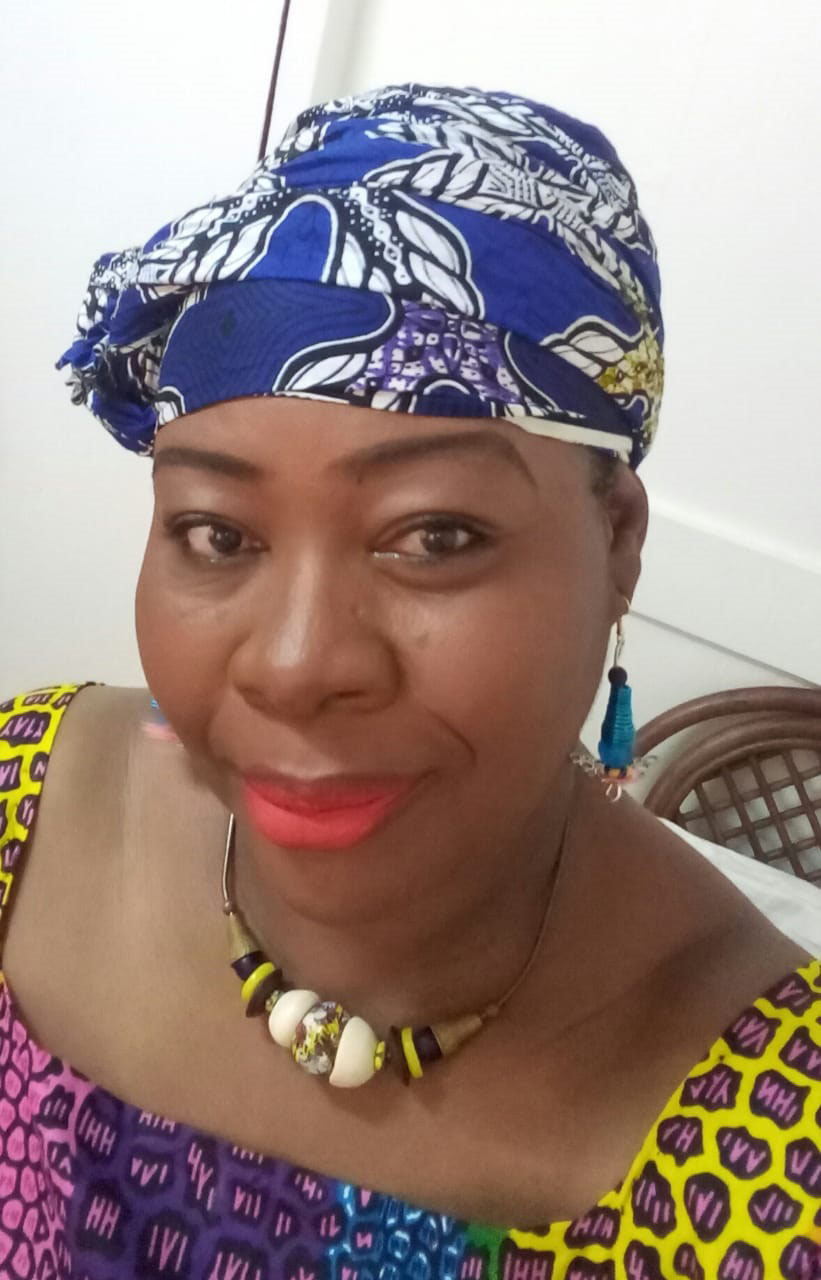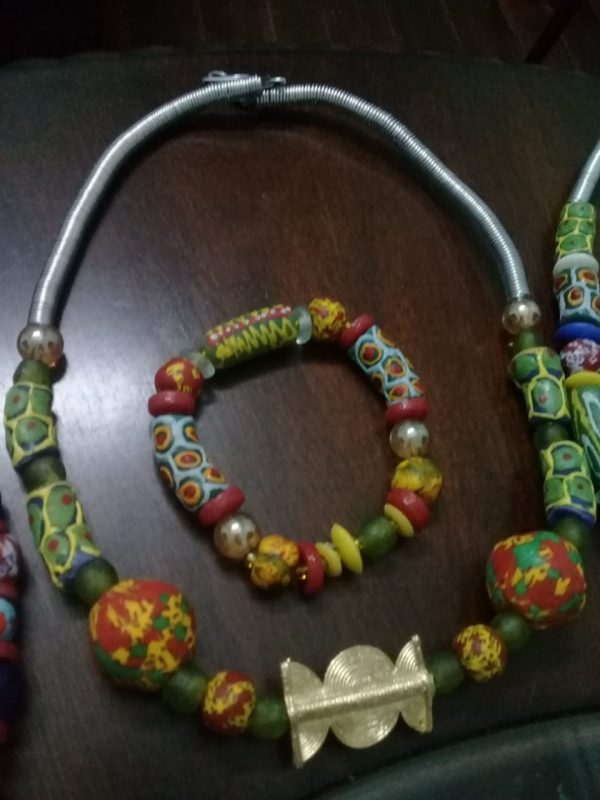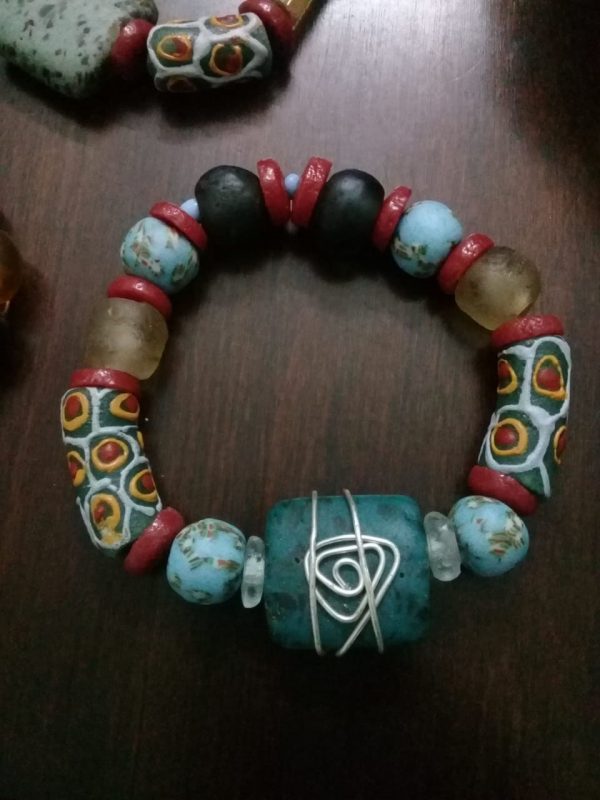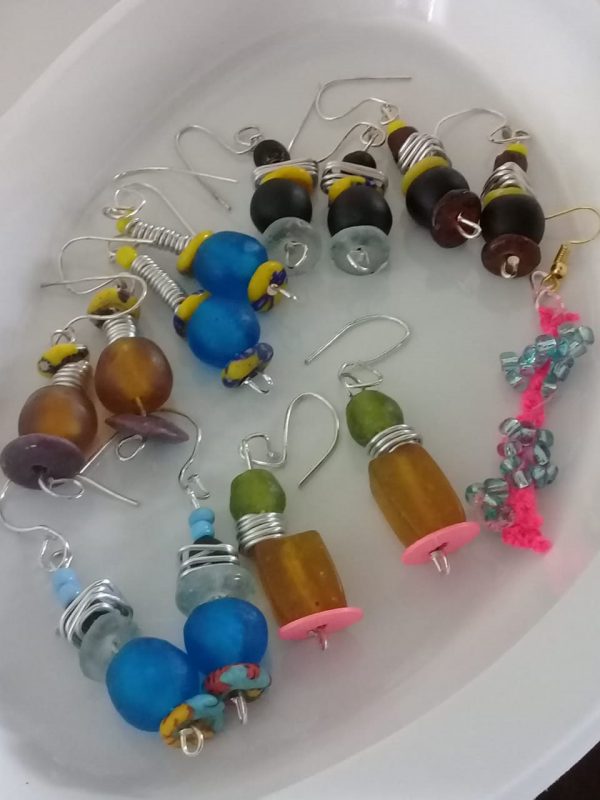Fatu Gbedema sat in the lobby at the Pegasus Hotel attired in her colourful African print accessorized by her beaded bracelets, ring and earrings; hers because she made them.
Fatu has been making jewelry for a long time now. It began as a hobby but has since become a side job for her. A closer look at the style of her jewelry reveals that they have traditional African flair and are contemporary also. However, most of her jewelry is a fusion of both styles.
Where Fatu comes from, jewelry plays an important role in the lives of her people. From birth, girls wear waist beads that help to shape their waists keeping them small. These beads are worn throughout their lifetime. They are expected to make their own waist beads. Many waist beads are soaked for months at a time in containers with fragrances and are only taken out to be worn when the ones being used are destroyed.
Fatu shared that in the olden times, girls around 15 and 16 years old would go to bush schools where they would learn to cook and make their own waist beads among other things a woman is expected to know. After months of training, an initiation is held where the girls display their beads before the villagers. Men looking for wives would be present to make their choices.
According to Fatu, the colours and style of the waist beads can tell a lot about a woman, whether she is vibrant or plain. Fatu still wears her waist beads.
Beads, in fact jewelry on the whole, are considered to be of great importance and usually the people who can afford to buy them are those considered middle class. Some are handed down to other generations and are to be kept within the family. Beads were once used as money in bartering.
Fatu did not disclose which country she was born in, but she did say that her mother is Liberian and her father, Ghanaian. Her late uncle Komla Agbeli Gbedemah (her father’s cousin) was part of the government under the Convention People’s Party in Ghana and served as minister of health and labour, commerce and industry, finance and health over different periods. He later founded his own party called National Alliance of Liberals.
Ewe tribe
Fatu lived in both Liberia and Ghana and by the time she was 10 years old she had already lived in three countries including the US. She said that although her parents are from different countries, they are from the same Ewe (pronounced ev-ay) tribe. Ewe women, Fatu said, are tall and big built, just as she is.
Sharing a bit of history, she said the clan was the only one where women went to war to protect their king. The Ewe tribe also, she said, was the only tribe that was never sold into slavery. “Slaves were sold with beads, that’s why they are also called trade beads,” Fatu said. “The slave coast in West Africa was where Nigeria is now. In those days it wasn’t Nigeria; there were empires. Slavery in West Africa was different from slavery here. When they sold these people as slaves, they never imagined what they were going to go through here. They thought they would have been treated like slaves in Africa or like servants. They didn’t know they were going to rob them of everything, their culture, their name, their dignity, everything. The people who did that were greedy and wanted more foreign goods. Sometimes it was that if you had people in your family who have a history of diseases and deformities, they would sell them into slavery so there were all kinds of reasons people were sold into slavery for. My tribe, for instance, we ran away from slavery. We left what is now the countries between Nigeria and Ghana, we left Benin and Togo; the Kingdom of Dahomey was what it was called before… were known to be slave traders. There three kings in succession, the king and his children and their children… they were so wicked that they sold most of their people into slavery. My tribe, the Ewe, ran from that.”
Jewelry
Returning to the subject at hand, Fatu said, “I’ve been involved in jewelry making since 2001. I started that as a hobby to help me go through a period, right after I had graduated from the University of Maryland. I had needed to wait for six months to get into the job I wanted. I was watching television at home in the States, a channel called the ‘Style Channel’ and they had a segment on jewelry making so I would watch it. Then I began buying books on it to learn more.
“I exhibited for the Margaret McNamara Fair which is an annual fair. Margaret McNamara was the wife of the first president of the World Bank and every year World Bank organizes an annual charity Christmas fair. It usually lasts for a week and all the artists in the DC, Virginia, Maryland areas as well as staff who are artists will exhibit their products. That was my first exhibition and I did that consistently for the six years that I was at the World Bank and IMF. And when I came to Guyana the second time around between 2008 and 2012, I exhibited about three times with GO-Invest. I exhibited at the Sidewalk Café about every three months and people would place orders.”
On returning to Liberia, Fatu started making jewelry again after noticing that the craft sector was very thin in terms of women being involved. A large percentage of the craft displayed was masks and carvings. There weren’t a lot of paintings and jewelry and so she decided to make jewelry again.
Most of the jewelry she makes is for everyday wear. She doesn’t wait until there is an exhibition to make jewelry but does it in her free time. For the most part of her stay in Guyana, Fatu worked with the UN, and made jewelry on the side. Her main goal regarding this is to someday have a store and export jewelry, though one of the biggest issues that hampers this is the weight of the jewelry and the cost of shipment. The beads Fatu makes her jewelry with are imported.
At the moment, she works along with the Board of Industrial Training trying to see how the beads can be made locally. The beads she uses are made of recycled glass. To make them, glass bottles of any colour are collected then pounded into powder. After this is sifted, it is added to really fine coloured sand, put into moulds, then baked. It is an industry which, if funded, can create a new kind of livelihood for jewelry makers in Guyana and allow for them to cut back on spending unnecessary dollars to import. In the meantime, persons wishing to make jewelry from scratch can use the clay found here to make the beads.
Jewelry is big in Liberia and Ghana, Fatu said, and because they attract tourists, hotels there have small shops that sell them.
Being a jeweler takes much patience and persons wishing to take this path should have a love for it otherwise, it will not be worth their time, the artist said. This is what she does in her free time but because she has such a passion for this art form, Fatu finds making jewelry therapeutic. She uses a very thin flexible needle to string the beads.
As Public Relations Officer for the Guyana Women Artists Association (the longest living group of women in art in the Caribbean) Fatu is assisting the group to do one community activity, have an annual exhibition and a fundraiser. She is currently making plans with the group to have the first activity – a food sale to provide funding for projects – at the end of this month. There is also to be an art auction where artists will be paid the value of their pieces and the remainder will go toward supporting other artists in Guyana.
Fatu has been tasked with the responsibility of doing a tour in Africa in January, sort of an art knowledge exchange programme. Guyanese artists will have the opportunity to visit art galleries in Ghana. Women can join the group and be a part of this project through Facebook after completing an online form and attaching a portfolio of their work.
Besides being a jeweler, Fatu has a background in Management Consulting. She has 2 children who are currently in Ghana with her mother. Over the years, she has lived in numerous countries having worked with the UN, but Guyana has stolen her heart. It is challenging to live here, she said, but there is something about the diversity of the people that keeps her. When she worked with the UN in the US, many of her colleagues were from different ethnic backgrounds and they got along well together. However, in most of the other countries she has lived in, including the ones she grew up in, there was almost always just one or two ethnic groups. Guyana, she said, has a little bit of many people of the world, which makes her feel right at home.
She wishes that Guyanese can see how fortunate they are to have each other. Fatu said that when she worked in the US, she noticed that because of their different ethnicities, her colleagues had different ideas and approaches which helped to build the organization they worked for. If Guyanese can come to realize their strengths in being different, she added, then they can use that to work for the better of Guyana; she was referring to Guyana’s new-found oil.
Since first coming to Guyana in 2008, Fatu not only likes the people but the cuisine, particularly pepper pot and black pudding. She does not know to make those dishes as yet but boasts that she can make chicken curry and roti.









